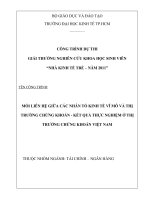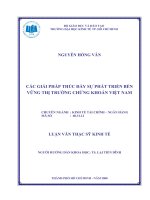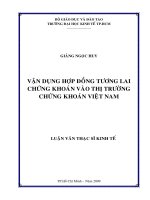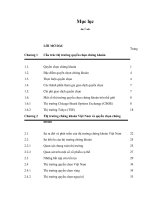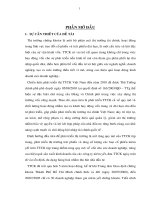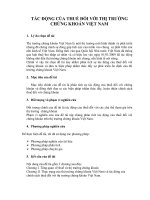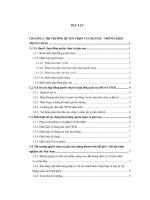Lựa Chọn Danh Mục Đầu Tư Dựa Trên Các Phương Pháp Ước Lượng Ma Trận Hiệp Phương Sai Nghiên Cứu Thực Nghiệm Trên Thị Trường Chứng Khoán Việt Nam.pdf
Bạn đang xem bản rút gọn của tài liệu. Xem và tải ngay bản đầy đủ của tài liệu tại đây (1.72 MB, 71 trang )
ỦY BAN NHÂN DÂN
THÀNH PHỐ HỒ CHÍ MINH
SỞ KHOA HỌC VÀ CƠNG NGHỆ
THÀNH ĐỒN TP. HỒ CHÍ MINH
TRUNG TÂM PHÁT TRIỂN
KHOA HỌC VÀ CƠNG NGHỆ TRẺ
CHƯƠNG TRÌNH KHOA HỌC VÀ CÔNG NGHỆ CẤP THÀNH PHỐ
BÁO CÁO TỔNG HỢP
KẾT QUẢ NHIỆM VỤ NGHIÊN CỨU KHOA HỌC VÀ CÔNG NGHỆ
LỰA CHỌN DANH MỤC ĐẦU TƯ DỰA TRÊN CÁC PHƯƠNG PHÁP ƯỚC LƯỢNG
MA TRẬN HIỆP PHƯƠNG SAI: NGHIÊN CỨU THỰC NGHIỆM TRÊN
THỊ TRƯỜNG CHỨNG KHỐN VIỆT NAM
Cơ quan chủ trì nhiệm vụ: Trung tâm Phát triển Khoa học và Công nghệ Trẻ
Chủ nhiệm nhiệm vụ: Ths. Nguyễn Minh Nhật
ỦY BAN NHÂN DÂN
THÀNH ĐỒN TP. HỒ CHÍ MINH
THÀNH PHỐ HỒ CHÍ MINH
TRUNG TÂM PHÁT TRIỂN
SỞ KHOA HỌC VÀ CƠNG NGHỆ
KHOA HỌC VÀ CƠNG NGHỆ TRẺ
CHƯƠNG TRÌNH KHOA HỌC VÀ CÔNG NGHỆ CẤP THÀNH PHỐ
BÁO CÁO TỔNG HỢP
KẾT QUẢ NHIỆM VỤ NGHIÊN CỨU KHOA HỌC VÀ CÔNG NGHỆ
LỰA CHỌN DANH MỤC ĐẦU TƯ DỰA TRÊN CÁC PHƯƠNG PHÁP ƯỚC LƯỢNG
MA TRẬN HIỆP PHƯƠNG SAI: NGHIÊN CỨU THỰC NGHIỆM TRÊN
THỊ TRƯỜNG CHỨNG KHOÁN VIỆT NAM
Chủ nhiệm nhiệm vụ:
(ký tên)
Chủ Tịch Hội Đồng nghiệm thu
(Ký và ghi rõ họ tên)
Nguyễn Minh Nhật
Cơ quan chủ trì nhiệm vụ
Đồn Kim Thành
Mẫu Báo cáo thống kê (trang 3 Báo cáo tổng hợp kết quả nhiệm vụ)
_________________________________________________________________________
THÀNH ĐỒN TP. HỒ CHÍ MINH
TRUNG TÂM PHÁT TRIỂN
KHOA HỌC VÀ CƠNG NGHỆ TRẺ
CỘNG HỒ XÃ HỘI CHỦ NGHĨA VIỆT NAM
Độc lập - Tự do - Hạnh phúc
__________________
............., ngày
tháng
năm 200...
BÁO CÁO THỐNG KÊ
KẾT QUẢ THỰC HIỆN NHIỆM VỤ NGHIÊN CỨU KH&CN
I. THÔNG TIN CHUNG
1. Tên nhiệm vụ:
Thuộc: Chương trình/lĩnh vực (tên chương trình/lĩnh vực): Vườn ươm Sáng tạo
Khoa học và Công nghệ trẻ
2. Chủ nhiệm nhiệm vụ:
Họ và tên: Nguyễn Minh Nhật
Ngày, tháng, năm sinh: 21/07/1989
Nam/ Nữ: Nam
Học hàm, học vị: Thạc sỹ
Chức danh khoa học: ............................................Chức vụ.....................
Điện thoại: 098.7362.226
E-mail:
Tên tổ chức đang công tác: Trường Đại học Ngân hàng TP.HCM
Địa chỉ tổ chức: 36 Tơn Thất Đạm, Quận 1, TP.HCM
3. Tổ chức chủ trì nhiệm vụ:
Tên tổ chức chủ trì nhiệm vụ: Trung tâm Phát triển Khoa học và Công nghệ trẻ
Điện thoại: 028.38.233.363 Fax: ..................................................
E-mail: ....................................................................................................
Website: .................................................................................................
Địa chỉ: Số 1 Phạm Ngọc thạch, Phường Bến Nghé, Quận 1
Họ và tên thủ trưởng tổ chức: Ơng: ĐỒN KIM THÀNH
Số tài khoản: 3713.0.1083277.00000
Kho bạc: Nhà nước Quận 1 Thành phố Hồ Chí Minh
II. TÌNH HÌNH THỰC HIỆN
1. Thời gian thực hiện nhiệm vụ:
- Theo Hợp đồng đã ký kết: từ tháng 12 năm 2019 đến tháng 12 năm 2020
- Thực tế thực hiện: từ tháng 12 năm 2020 đến tháng 12 năm 2020
- Được gia hạn (nếu có):
3
- Lần 1 từ tháng…. năm…. đến tháng…. năm….
- Lần 2 ….
2. Kinh phí và sử dụng kinh phí:
a) Tổng số kinh phí thực hiện: 90.000.000 VND, trong đó:
+ Kính phí hỗ trợ từ ngân sách khoa học: ………………….tr.đ.
+ Kinh phí từ các nguồn khác: ……………….tr.đ.
b) Tình hình cấp và sử dụng kinh phí từ nguồn ngân sách khoa học:
Số
TT
1
2
…
Theo kế hoạch
Thời gian
Kinh phí
(Tháng, năm)
(Tr.đ)
Thực tế đạt được
Thời gian
Kinh phí
(Tháng, năm)
(Tr.đ)
Ghi chú
(Số đề nghị
quyết toán)
c) Kết quả sử dụng kinh phí theo các khoản chi:
Đối với đề tài:
Số
TT
1
2
3
4
5
Nội dung
các khoản chi
Đơn vị tính: Triệu đồng
Theo kế hoạch
Tổng
NSKH
83.000
Trả cơng lao động
(khoa học, phổ
thơng)
Ngun, vật liệu,
năng lượng
Thiết bị, máy móc
Xây dựng, sửa chữa
nhỏ
Chi khác
Tổng cộng
Nguồn
khác
Thực tế đạt được
Tổng
NSKH
83.000
7.000
90.000
Nguồn
khác
7.000
90.000
- Lý do thay đổi (nếu có):
Đối với dự án:
Đơn vị tính: Triệu đồng
Số
TT
Nội dung
các khoản chi
1
Thiết bị, máy móc
mua mới
Nhà xưởng xây dựng
mới, cải tạo
Kinh phí hỗ trợ cơng
nghệ
Chi phí lao động
Ngun vật liệu,
năng lượng
2
3
4
5
Theo kế hoạch
Tổng
NSKH
4
Nguồn
khác
Thực tế đạt được
Tổng
NSKH
Nguồn
khác
6
7
Thuê thiết bị, nhà
xưởng
Khác
Tổng cộng
- Lý do thay đổi (nếu có):
3. Các văn bản hành chính trong q trình thực hiện đề tài/dự án:
(Liệt kê các quyết định, văn bản của cơ quan quản lý từ công đoạn xét duyệt, phê duyệt kinh phí, hợp
đồng, điều chỉnh (thời gian, nội dung, kinh phí thực hiện... nếu có); văn bản của tổ chức chủ trì nhiệm
vụ (đơn, kiến nghị điều chỉnh ... nếu có)
Số
TT
1
2
…
Số, thời gian ban
hành văn bản
Tên văn bản
Ghi chú
4. Tổ chức phối hợp thực hiện nhiệm vụ:
Số
TT
1
2
...
Tên tổ chức
đăng ký theo
Thuyết minh
Tên tổ chức đã
tham gia thực
hiện
Nội dung
tham gia chủ
yếu
Sản phẩm
chủ yếu đạt
được
Ghi chú*
- Lý do thay đổi (nếu có):
5. Cá nhân tham gia thực hiện nhiệm vụ:
(Người tham gia thực hiện đề tài thuộc tổ chức chủ trì và cơ quan phối hợp, khơng q 10 người
kể cả chủ nhiệm)
Số
TT
1
2
3
4
5
6
7
8
Tên cá nhân
đăng ký theo
Thuyết minh
Nguyễn Minh
Nhật, Thạc sĩ
Trần Anh Tuấn,
Thạc sĩ
Bùi Quang Tín,
Tiến sĩ
Nguyễn Thị Ngọc
Nga, Tiến sĩ
Nguyễn Đức
Trung, PGS.TS
TS. Mai Hoàng
Bảo Ân, Tiến sĩ
Phùng Thị Hồng
Gấm, Thạc sĩ
Tên cá nhân đã
tham gia thực
hiện
Nguyễn Minh
Nhật, Thạc sĩ
Trần Anh Tuấn,
Thạc sĩ
Bùi Diệu Anh,
Tiến sĩ
Nguyễn Thị Ngọc
Nga, Tiến sĩ
Nguyễn Đức
Trung, PGS.TS
TS. Mai Hoàng
Bảo Ân, Tiến sĩ
Phùng Thị Hồng
Gấm, Thạc sĩ
Nguyễn Trần
Phúc, Tiến sĩ
Chức vụ
Chủ nhiệm đề
tài
Thành viên
chính
Thành viên
chính
Thành viên
chính
Thành viên
chính
Thành viên
chính
Thành viên
chính
Thành viên
chính
- Lý do thay đổi ( nếu có): TS. Bùi Quang Tín đã mất
5
Sản phẩm
chủ yếu đạt
được
Ghi
chú*
6. Tình hình hợp tác quốc tế:
Số
TT
1
2
...
Theo kế hoạch
(Nội dung, thời gian, kinh phí, địa
điểm, tên tổ chức hợp tác, số
đoàn, số lượng người tham gia...)
Thực tế đạt được
(Nội dung, thời gian, kinh phí, địa
điểm, tên tổ chức hợp tác, số
đoàn, số lượng người tham gia...)
Ghi chú*
- Lý do thay đổi (nếu có):
7. Tình hình tổ chức hội thảo, hội nghị:
Theo kế hoạch
Số
(Nội dung, thời gian, kinh phí, địa
TT
điểm )
1
2
...
Thực tế đạt được
(Nội dung, thời gian, kinh
phí, địa điểm )
Ghi chú*
- Lý do thay đổi (nếu có):
8. Tóm tắt các nội dung, công việc chủ yếu:
(Nêu tại mục 15 của thuyết minh, không bao gồm: Hội thảo khoa học, điều tra khảo sát trong
nước và nước ngoài)
Số
TT
Thời gian
(Bắt đầu, kết thúc
- tháng … năm)
Theo kế
Thực tế đạt
hoạch
được
Các nội dung, công việc
chủ yếu
(Các mốc đánh giá chủ yếu)
1
2
...
Người,
cơ quan
thực hiện
- Lý do thay đổi (nếu có):
III. SẢN PHẨM KH&CN CỦA NHIỆM VỤ
1. Sản phẩm KH&CN đã tạo ra:
a) Sản phẩm Dạng I:
Số
TT
1
Tên sản phẩm và chỉ
tiêu chất lượng chủ
yếu
Báo cáo tổng hợp
kết quả nghiên cứu,
kiến nghị
Đơn
vị đo
Số lượng
01
Theo kế
hoạch
Báo cáo
tổng hợp
2
...
- Lý do thay đổi (nếu có):
b) Sản phẩm Dạng II:
6
Thực tế
đạt được
Báo cáo tổng
hợp
Số
TT
Tên sản phẩm
1
2
...
Yêu cầu khoa học
cần đạt
Theo kế hoạch
Thực tế
đạt được
Ghi chú
- Lý do thay đổi (nếu có):
c) Sản phẩm Dạng III:
Số
TT
1
Tên sản phẩm
Shrinkage Model Selection
for Portfolio Optimization
on Vietnam Stock Market
Yêu cầu khoa học
cần đạt
Theo
Thực tế
kế hoạch
đạt được
Tạp chí thuộc
Tạp chí thuộc
danh mục
danh mục
SCOPUS
SCOPUS
Số lượng, nơi
cơng bố
(Tạp chí, nhà
xuất bản)
Journal of
Asian Finance,
Economics and
Business
Số lượng
Theo kế hoạch
Thực tế đạt
được
Ghi chú
(Thời gian kết
thúc)
2
...
- Lý do thay đổi (nếu có):
d) Kết quả đào tạo:
Số
TT
Cấp đào tạo, Chuyên ngành
đào tạo
1
2
Thạc sỹ
Tiến sỹ
- Lý do thay đổi (nếu có):
đ) Tình hình đăng ký bảo hộ quyền sở hữu công nghiệp:
Số
TT
Tên sản phẩm
đăng ký
1
2
...
Kết quả
Theo
kế hoạch
Thực tế
đạt được
Ghi chú
(Thời gian kết
thúc)
- Lý do thay đổi (nếu có):
e) Thống kê danh mục sản phẩm KHCN đã được ứng dụng vào thực tế
Số
TT
Tên kết quả
đã được ứng dụng
Thời gian
1
2
2. Đánh giá về hiệu quả do nhiệm vụ mang lại:
7
Địa điểm
(Ghi rõ tên, địa
chỉ nơi ứng dụng)
Kết quả
sơ bộ
Về mặt lý thuyết, kết quả nghiên cứu sẽ góp phần bổ sung vào cơ sở lý thuyết về sự
tác động của ma trận hiệp phương sai đến kết quả lựa chọn danh mục đầu tư tối ưu trong lý
thuyết danh mục hiện đại (MPT). Kết quả đã cho thấy tính hiệu quả của phương pháp ước
lượng ma trận hiệp phương sai trong việc lựa chọn danh mục đầu tư tối ưu, đặc biệt trên thị
trường tài chính mới nổi giống như thị trường Việt Nam.
Về mặt thực tiễn, kết quả nghiên cứu sẽ giúp cho các nhà quản lý quỹ, các nhà quản lý
danh mục đầu tư lựa chọn được phương pháp ước lượng ma trận hiệp phương sai phù hợp để
tối ưu danh mục đầu tư của họ trên thị trường chứng khốn Việt Nam, từ đó giảm thiểu rủi ro
và gia tăng hiệu quả trong hoạt động đầu tư và quản lý danh mục.
3. Tình hình thực hiện chế độ báo cáo, kiểm tra của nhiệm vụ:
Số
TT
I
II
III
Nội dung
Thời gian
thực hiện
Báo cáo tiến độ
Lần 1
…
Báo cáo giám định
Lần 1
….
Nghiệm thu cơ sở
……
Chủ nhiệm đề tài
(Họ tên, chữ ký)
Ghi chú
(Tóm tắt kết quả, kết luận
chính, người chủ trì…)
Thủ trưởng tổ chức chủ trì
(Họ tên, chữ ký và đóng dấu)
8
Table of Contents
List of Abbreviations ................................................................................................................................. iii
List of Figures............................................................................................................................................. iv
List of Tables ............................................................................................................................................... v
CHAPTER 1: INTRODUCTION .............................................................................................................. 1
1.1.
Background ................................................................................................................................... 1
1.2.
Purpose, research questions and expected contribution ................................................................ 3
1.3.
Disposition of the study ................................................................................................................ 5
CHAPTER 2: LITERATURE REVIEW .................................................................................................. 6
2.1 Modern Portfolio Theory Framework ................................................................................................. 6
2.2 Parameter estimation ........................................................................................................................... 7
2.3 Portfolio Selection ............................................................................................................................ 12
CHAPTER 3: THEORETICAL FRAMEWORK ................................................................................. 14
3.1
Basic preliminaries...................................................................................................................... 14
3.1.1 Return......................................................................................................................................... 14
3.1.2 Variance ..................................................................................................................................... 14
3.2
Portfolio Optimization ................................................................................................................ 15
3.3
Estimating the covariance matrix ................................................................................................ 15
CHAPTER 4: METHODOLOGY........................................................................................................... 20
4.1 Input Data.......................................................................................................................................... 20
4.2. Back-Testing Process ....................................................................................................................... 21
4.3. Performance Metrics ........................................................................................................................ 22
4.4 VNINDEX and 1/N portfolios benchmark ....................................................................................... 25
CHAPTER 5: EMPIRICAL RESULTS ................................................................................................. 26
5.1
VNINDEX and 1/N portfolio performance................................................................................. 26
5.2
Portfolio out – of –sample performance...................................................................................... 28
5.1.1 Sample covariance matrix .......................................................................................................... 28
5.1.2 Shrinkage towards Single index model ...................................................................................... 31
5.1.3 Shrinkage towards Constant correlation model ........................................................................ 35
5.1.4 Shrinkage towards Identity Matrix ............................................................................................ 39
i
5.3
Summary of out – of –sample performance ................................................................................ 43
5.4
Conclusions ................................................................................................................................. 44
REFERENCES ..............................................................................................................................................
ii
List of Abbreviations
APT: Arbitrage pricing theory
CAPM: Capital Asset Pricing Model
CCM: Constant correlation model
GMV: Global minimum variance model
HOSE: Ho Chi Minh City Stock Exchange
MDD: Maximum drawdown
MLE: Maximum likelihood estimator
MV: Mean - Variance
MVO: Mean-Variance Optimization
MPT: Modern Portfolio Theory
SCM: The sample covariance matrix
SIM: The single index market model
SSIM: Shrinkage towards the single-index model
SCCM: Shrinkage towards Constant correlation Model
STIM: Shrinkage to identity matrix
SR: Sharpe ratio
VNINDEX: Vietnam stock index
iii
List of Figures
Figure 4.1: Back – testing procedure
Figure 5.1: VNINDEX’s performance
Figure 5.2: The annual return and turnover of 1/N portfolio benchmark
Figure 5.3: The sample covariance matrix’s annual return
Figure 5.4: The sample covariance matrix’s daily turnover
Figure 5.5: The sample covariance matrix’s maximum drawdown
Figure 5.6: The sample covariance matrix’s sharpe ratio
Figure 5.7: Compare the cumulative return between the SCM and VNINDEX
Figure 5.8: The Shrinkage towards Single index model’s annual return
Figure 5.9: The Shrinkage towards Single index model’s daily turnover
Figure 5.10: The Shrinkage towards Single index model’s maximum drawdown
Figure 5.11: The Shrinkage towards Single index model’s sharpe ratio
Figure 5.12: Shrinkage intensity of Shrinkage towards Single index model
Figure 5.13: Compare the cumulative return between the SSIM and VNINDEX
Figure 5.14: The Shrinkage towards constant correlation model’s annual return
Figure 5.15: The Shrinkage towards constant correlation model’s daily turnover
Figure 5.16: The Shrinkage towards constant correlation model’s maximum drawdown
Figure 5.17: The Shrinkage towards constant correlation model’ s sharpe ratio
Figure 5.18: Shrinkage intensity of SCCM
Figure 5.19: Compare the cumulative return between the SCCM and VNINDEX
Figure 5.20: The Shrinkage towards identity matrix’s annual return
Figure 5.21: The Shrinkage towards identity matrix’s sharpe ratio
Figure 5.22: The Shrinkage towards identity matrix’s daily turnover
Figure 5.23: The Shrinkage towards identity matrix’s maximum drawdown
Figure 5.24: Shrinkage intensity of STIM
Figure 5.25: Compare the cumulative return between the STIM and VNINDEX
iv
List of Tables
Table 5.1: The performance of the 1/N portfolio benchmark from 1/1/2013 – 1/1/2019
Table 5.2: Backtesing results of SCM on out – of – sample from 1/1/2013 – 31/12/2019
Table 5.3: Backtesting results of SSIM on out – of – sample from 1/1/2013 – 31/12/2019
Table 5.4: Backtesting results of SCCM on out – of – sample from 1/1/2013 –
31/12/2019
Table 5.5: Backtesting results of STIM on out – of – sample from 1/1/2013 – 31/12/2019
Table 5.6: Summary backtesting results of covariance matrix estimation techniques on
out – of – sample from 1/1/2013 – 31/12/2019
v
CHAPTER 1: INTRODUCTION
1.1. Background
Modern Portfolio Theory (MPT) has been playing an important role in the selection and
construction of investment portfolios for over 65 years, since it was firstly introduced by
Harry Markowitz in his “Portfolio Selection” (1952) article. The investment framework
attempts to maximize portfolio expected return for a given level of portfolio risk, or
equivalently minimize portfolio risk for a given level of expected return through selecting
the optimal weights of various assets (Iyiola, 2012). Although MPT is widely used in
practical investment activities, the basic assumptions of the MPT model have been facing
great challenges in recent years. One of the main reasons comes from the two main inputs
of MPT that are the mean and the covariance matrix of asset returns.
To implement these portfolios in practice, the investors have to estimate the mean and the
covariance matrix of asset returns. Traditionally, the sample mean and covariance matrix
have been used for this purpose. However, these estimators are not really stable in many
cases because of estimation error, this makes the weights of portfolio fluctuate
continuously over time. As a result, the mean – variance portfolios are difficult to be
applied in practice by the portfolio managers. Moreover, many well – known empirical
evidences showed that these portfolios perform very poorly in the out – of – sample mean
and variance (Michaud, 1989).
The instability of the mean-variance portfolios comes from estimating the mean assets
return. Because of the reason, the minimum – variance portfolios have recently been
used by many researchers. The portfolios based solely on the covariance matrix
estimation, so they are not as sensitive to the estimation errors (Chan et al. 1999,
Jagannathan and Ma, 2003). Jagannathan and Ma, for example, state that “the
estimation error in the sample mean is so large that nothing much is lost in ignoring the
mean altogether”. This claim is demonstrated by extensive empirical evidence that
shows the minimum-variance portfolio usually performs better out of sample than any
1
other mean-variance portfolio on Sharpe ratio and other performance metrics
(DeMiguel, 2005; Jagannathan and Ma, 2003).
Demiguel (2009) stated that although the minimum-variance portfolio does not depend
on the mean returns estimation, it is still under great impact of estimation error. The
sensitivity of the minimum-variance portfolio to estimation error is quite interesting.
“These portfolios are based on the sample covariance matrix, which is the maximum
likelihood estimator (MLE) for normally distributed returns. Moreover, MLEs are
theoretically the most efficient for the assumed distribution; that is, these estimators have
the smallest asymptotic variance provided the data follows the assumed distribution”. So
why does the sample covariance matrix generate the unsuitable portfolios? Huber (2004)
answered that “the efficiency of MLEs based on assuming normality of returns is highly
sensitive to deviations of the asset-return distribution from the assumed (normal)
distribution. In particular, MLEs based on the normality assumption are not necessarily
the most efficient for data that depart even slightly from normality”. This is really helpful
for portfolio selection, where extensive evidence shows that the empirical distribution of
returns is usually different from the normal distribution.
Moreover, although the core of minimum - variance portfolio researches relies solely on
how to estimate reliably the covariance matrix, however, almost traditional approaches of
covariance matrix estimation such as using the sample covariance matrix (SCM) or
ordinary least squares (OLS) face many problems in the case of high-dimensional
portfolios. Having large dimensionality means that it is easier to get unexpected and
uncontrollable errors in some of computational steps, and the sample data may not be
enough for the estimation of the true covariance matrix. These lead to the estimated
covariance matrix to become ill-conditioned or even singular which is very popular in
matrix computation research. Consequently, the portfolios selected from considering the
sample covariance matrix often perform poorly and fail in generating profit. To solve this
problem, there's a brilliant research direction of shrinkage estimators in covariance matrix
estimation that is first introduced by Ledoit and Wolf (2003).
2
The general idea of this approach is to pose a control on the tradeoff between the bias and
the variance of covariance matrix estimation via considering a pre-defined and wellconditioned target matrix F and a shrinkage intensity σ that can be computed from sample
covariance matrix and F mathematically. The target matrix F of LW shrinkage could be
estimated from a single index model, a constant correlation model or identity matrix. The
findings by Ledoit and Wolf (2003) are really interesting and benefit for the investment
managers. More importantly, “the research poses a problem (or an opportunity) regarding
whether financial practitioners that today employ the traditional covariance matrix
estimation technique should alter their quantitative models. Clearly, the choice of
estimation technique for the covariance matrix affect the MV optimized portfolios. The
problem is that there is an inadequate body of research regarding the effect of out-ofsample performance when solely varying the estimation technique for the covariance
matrix. In other words, there is not a strong foundation regarding this field and
investment managers are most likely not willing to risk capital based on frontier research
that has not yet proven to stand up under close scrutiny”.
Moreover, there are not many researches in Vietnam relating to the choice of estimation
technique for the covariance matrix to select the optimized portfolios, especially in the
shrinkage methods. Therefore, there is a gap for the author to apply the shrinkage
methods to estimate the covariance matrix for minimum – variance portfolio optimization
on Vietnam stock market.
1.2.
Purpose, research questions and expected contribution
The purpose of this study is that the use of shrinkage estimators that are a linear
combination of sample covariance matrices and a target matrix to estimate the covariance
matrix, where the target matrix is the identity matrix and applying this estimation method
to the minimum variance portfolio optimization procedure to produce the stable and
reliable stock portfolios on the Vietnam stock market. Besides, the author will compare
the performance of shrinkage methods with not only the performance of the traditional
3
covariance matrix estimation, but also the performance of portfolios benchmark based on
out – of – sample of the performance metrics.
This author will attempt to achieve the purpose of this study by answering the following
research questions:
Question 1: How do the shrinkage estimators of covariance matrix perform on out – of –
sample in selecting the minimum – variance optimized portfolios?
Question 2: How does the shrinkage intensity work among three linear shrinkage
estimations for portfolio selection?
After answering the research questions above, this study will expect to make three
contributions as follows. The first contribution is to expect adding to the current
knowledge regarding the robustness of different covariance estimation techniques, from
that providing insight for financial practitioners in using minimum – variance
optimization in their quantitative models. The second contribution is to show how well
the shrinkage estimators perform in selecting the minimum – variance optimized
portfolios. The portfolios performance will be evaluated by the performance metrics such
as sharpe ratio, variance, turnover, MDD or Jensen’s Alpha. If the shrinkage estimators
perform well, it shows that an investor can select an optimal portfolio in the absence of
financial knowledge. The final contribution is that the shrinkage method has been
experimented on Vietnam stock market where is considered as an emerging market.
There are many researches using the shrinkage to identity matrix to optimize the
investment portfolios on the developed financial market such as US or European,
however, there are very few researches employing this method on the emerging market,
especially on Vietnam stock market.
4
1.3.
Disposition of the study
This study includes 5 chapters, in which Chapter 1 focuses on the problem statements,
purpose of the study, research questions as well as expected contributions of the research.
The next chapters are presented as follows:
Chapter 2, Literature Review, provides a literature review of relevant researches within
the area of portfolio optimization. Depending on this work, the theoretical framework and
methodology will be developed in the next chapter.
Chapter 3, Theoretical Framework, presents the underlying theory that underlies this
study. First, some basic preliminaries and portfolio optimization problem will be
introduced in this chapter, and then theory regarding the covariance matrix estimations
will be presented.
Chapter 4, Methodology, presents the general methodology employed for investigating
the research questions in this study.
Chapter 5, Empirical Results and Conclusions, provides the empirical findings in this
study and concludes the study and presents some suggestions for further research.
5
CHAPTER 2: LITERATURE REVIEW
2.1 Modern Portfolio Theory Framework
Harry Markowitz is seen as a pioneer of his theoretical contributions to financial
economics and corporate finance. In 1990, Markowitz shared the Nobel Prize for his
contributions to these fields, especially in his “Portfolio Selection” (1952) article that was
first published in The Journal of Finance and more broadly in his book, “Portfolio
Selection: Efficient Diversification (1959). His groundbreaking work formed the basis of
what is now commonly known as Modern Portfolio Theory (MPT).
The MPT is an investment framework for the selection and construction of investment
portfolios that attempts to maximize portfolio expected return for a given amount of
portfolio risk, or equivalently minimize risk for a given level of expected return, through
carefully selecting the weights of different assets. Although the MPT is commonly used
in the financial industry, the basic assumptions of the MPT are still controversial in
recent years.
The MPT which is an improvement on the traditional investment models plays an
important role in the mathematical modeling of finance. This theory encourages the
diversification to prevent the investment portfolios from market risk as well as specific
risk of company. The theory is also called Portfolio Management Theory because it
supports the investors to classify, evaluate and measure both the expected risk and return.
Essential to the portfolio theory are its quantification of the relationship between risk and
return and the assumption that investors must be compensated for assuming risk.
The diversification concept of MPT is to select the investment portfolios that have lower
risk than any security in the portfolios. The diversification can lower the investment risk
no matter what the correlation between security returns is positive or negative. More
technically, the MPT considers a security return as a normally distributed function and
risk as the standard deviation of return. The return of a portfolio will be determined as the
weighted combination of the securities’ returns. The total variance of the portfolio return
6
will be reduced if the correlation between the securities’ returns is not perfectly
positively. Moreover, MPT assumes that an investor is rational and market is efficient.
Investing can be seen as a trade-off between risk and expected return. Generally, an asset
with higher expected return is riskier (Taleb, 2007). For a given level of risk, the MPT
describes how to choose a portfolio with the highest possible expected return. Or, for a
given level of expected return, the MPT explains how to choose a portfolio with the
lowest possible risk.
2.2 Parameter estimation
.2.2.1 Expected returns parameter
Capital Asset Pricing Model (CAPM) which was first introduced by William Sharpe in
1964 was built on the background of MPT and considered as a one – factor model to
forecast the expected return of assets. This model describes the relationship between
systematic risk and expected return for assets. In 1992, Eugene Fama, an American
Professor in finance, along with Kenneth French discovered that the beta coefficient of
CAPM did not explain the expected returns of US securities from 1963 to 1990. FamaFrench began to observe two classes of stocks that tend to perform better than the whole
market. The first is stocks with small caps and the second is stocks with a high Book to
Market Equity ratio. They added these two factors to CAPM model to reflect the
sensitivity of the portfolio to two types of stocks. After being introduced in 1993, a threefactor model by Fama-French authors has been tested on the developed stock market as
well as the emerging market and showed the effectiveness of the model. The FamaFrench three-factor model states that the return of a particular portfolio or stock depends
on three factors including market return, size risk and value risk factors. Fama and French
(2014) continued to introduce a 5-factor model to predict the expected return of portfolio
with two new factors that are profitability and investment factors.
7
Moreover, the researchers also employed robust estimators to improve the expected
return estimation. For examples, instead of using the sample mean m =
𝟏
𝑻
∑𝑻𝟏 𝒓𝒕 to
estimate population expected returns, the sample truncated/trimmed mean or Winsorized
can be used (Martin, Clark and Green, 2010). The trimmed mean is calculated after
removing the k% most extreme values, while the winsorized mean is estimated after
replacing those values with the next k% most extreme values. However, both estimators
are more efficient to deviations from distributional assumptions on assets return, so if
the returns are not stationary, not only both estimators but also the other robust
estimators like M – estimator or S – estimator could not provide the true estimates of
expected returns.
To improve performance in the face of non-stationary returns and to automate the
selection of tuning parameters, researchers have turned to Shrinkage Estimators. The
shrinkage approach begins with the observation that, much like uncertainty in actual
expected returns (asset risk), uncertainty in the estimate of expected returns (estimation
risk) implies a loss of investor utility (Jorion, 1985). Thus, the optimization problem
should minimize utility loss from selecting a portfolio based on sample estimates,
instead of true values. In this line of thought, the solution is clearly not to estimate each
asset’s expected return individually, but to select an estimator that minimizes utility loss
from aggregate parameter uncertainty. Jorion (1986) suggests using a Bayes–Stein
estimator that shrinks each asset’s sample mean mi to the grand mean m
̅ =
1
N
∑N
1 mi .
Through the simulation, this estimator reduce risk of portfolio and outperforms
portfolios constructed by mT .
The improvement of estimating assets’ expected returns is one of the ways to remedy
MPT’s shortcomings. However, the results of Merton’s research (1980) showed that it is
not easy to estimate the expected return (µ). In most asset price models, they made an
assumption that there is a relationship between the assets’ expected return and the
market’s expected return (µm), in which (µm) is constant overtime. Although this
8
assumption makes the assets’ expected return estimation to be easier, it would still take a
very long time series to estimate µ accurately (Merton, 1980). Moreover, all we know
that the assumption of constant expected return is not reasonable, but if this assumption is
relaxed, the estimating µ will be even harder. This paves the way for a second research
direction, selecting portfolios based on the covariance matrix estimation instead of the
expected return estimation.
2.2.2 The covariance matrix parameter
This is an important research direction that researchers have paid special attention to in
the recent period, due to the potential of this method in improving stability and
minimizing risks in selecting the investment portfolios. The traditional covariance matrix
estimation for portfolio optimization is to use the sample covariance matrix (SCM).
However, Michaud (1989) has proved that this estimation method brings many
shortcomings and limitations that contain a lot of statistical errors and become ill –
conditioned when the number of samples is comparable with the number of assets.
Michaud described this phenomenon as "Markowitz enigma". Frankfurter, Phillips and
Seagle (1971) also confirmed that the sample covariance matrix estimation for MPT
model does not bring superior results compared to an equally weighted portfolio selection
that DeMiguel (2009) called as the naïve 1/N portfolio.
Based on the single-index model given by Sharpe (1964), the researchers estimated the
covariance matrix to select the optimal portfolio. The covariance matrix estimated from
2
the one-factor model will be calculated as follows. ∑𝑆𝐼𝑀 = 𝛽𝛽𝑇 𝜎𝑚
+ ∑𝜀 . The SIM has
three advantages over standard MPT approach that the covariance matrix is estimated by
sample. First, SIM requires estimating only 2N+1 parameters to construct the covariance
matrix versus the N(N+1)/2 parameters required by the standard approach (exceeds 2N
+1 for N ≥ 4, N is the number of assets). Second, whenever the investors add a new asset
to their sample, they only need to estimate its β and 𝜎𝜀 to update their precision matrix,
versus estimating the asset’s variance and covariance with every other asset in their
sample (N + 1 parameters) and inverting their new covariance matrix to update their
9
precision matrix. Finally, the SIM approach only requires T > 2 observations to estimate
2
β and 𝜎𝜀 for every asset (as well as 𝜎𝑚
) and thus to estimate the precision matrix. On the
contrary, the standard MPT approach requires T > N (T is the sample size). In the
research of Senneret et al., (2016), there is ample evidence that the SIM approach
produces portfolios that are much less sensitive to estimation error than the standard
approach and, therefore, perform better across a range of risk and return metrics.
However, both the standard and SIM approach to portfolio selection are vulnerable to
estimation error from using the sample mean returns vector 𝑚 𝑇 (SIM is also exposed to
2
estimation error from 𝜎̂𝑚
).
To overcome the limitation of the SIM, Elton and Gruber (1973) proposed the other
approach that is called Constant Correlation Model (CCM). The model assumes that all
stocks have the same correlation, equal to the sample (historical) mean correlation. The
CCM implicitly assumes that the historical correlation matrix only contains information
about the average correlation for future periods, but no information about pairwise
correlations’ deviation from that average. Clearly, this is a strong assumption in this
model. Elton et al. (2009) summarizes the literature’s findings that the CCM is more
accurate forecasts of future covariance matrices than the sample covariance matrix and
SIM, from that producing portfolios with superior performance than competing models,
across a range of metrics. However, this CCM model still faces many problems in
estimating large dimensional covariance matrix for portfolio choice.
Ledoit và Wolf (2003) introduced a new approach to estimate the covariance matrix for
portfolio selection that is called shrinkage method. The approach is the weighted
combination between the sample covariance matrix and a target matrix of the same
dimensions. The objective is to reach a weighted average that is closest to the true
covariance matrix according to an intuitively appealing criterion. This approach becomes
more suitable (i) the less the bias introduced by the shrinkage target matrix, (ii) the larger
̂ 𝑆ℎ𝑟𝑖𝑛𝑘 =
the noise in the data, and (iii) the larger N/T. In general, the idea is to estimate ∑
̂ 𝑡𝑎𝑟𝑔𝑒𝑡 , where ẟ∗ is determined by a data-driven algorithm and ∑
̂ 𝑡𝑎𝑟𝑔𝑒𝑡 is
(1 - ẟ∗ )𝑆𝑇 +ẟ∗ ∑
10
chosen through some prior belief about asset return covariance. In terms of target matrix,
̂ 𝐶𝐶𝑀 (Constant Correlation Model) that based on
Ledoit and Wolf (2003a) recommend ∑
the prior belief that all stocks have the same correlation and equal to the mean
̂ 𝑆𝐼𝑀 (Single index model) that the
correlation, while Ledoit and Wolf (2003b) suggest ∑
known feature that stock returns have a factor – model structure. However, Ledoit and
Wolf (2004) proposed a target matrix that does not based any benefit from the application
– specific knowledge like the two previous shrinkage methods. The target matrix is an
̂ 𝐼𝑀 that is a square matrix in which all the elements of the principal
Identity matrix ∑
diagonal are ones and all other elements are zeros. With the introduction of this kind of
this target matrix, LW tries to answer the question of whether an investor can choose an
optimal portfolio if they are not using any the domain knowledge in finance field. Ledoit
and Wolf find that “all three ‘improved’ estimators of the covariance matrix dominated
the sample covariance matrix, but there was no clear winner among the three. If anything,
shrinkage to the constant-correlation matrix was best for portfolio sizes N ≤ 100, whereas
shrinkage to the single-factor matrix was best for portfolio sizes N ≥ 225”.
In the recent time, the newer work has focused on non – linear shrinkage estimators that
continue to answer the question whether it is possible to generalize and improve linear
shrinkage to the identity matrix in the absence of financial knowledge or in other words
whether the investors can be totally ignorant about the true covariance matrix and still do
better than generic linear shrinkage (Ledoit and Wolf, 2018). The non – linear shrinkage
estimators do not try to predict the true covariance matrix, this shrinkage method
considers the eigenvalues distribution of covariance matrix instead. So the non-linear
shrinkage method shows the flexibility in estimating eigenvalues of covariance matrix
compared to the linear shrinkage method, which can only estimate specific eigenvalue
values via the linear function. Ledoit and Wolf (2012, 2015) proposed the QuEST
function to estimate the covariance matrix in the non-linear shrinkage method with the
assumption that the number of investment assets and the observed data sample are
approaching to infinity, this method is called an indirect nonlinear shrinkage. Lam (2016)
continued to improve the non-linear shrinkage method by introducing a new approach
11
NERCOME (Nonparametric Eigenvalue-Regularized Covariance Matrix Estimator) by
separating the observation sample into 2 separate parts, partly for calculating
eigenvectors and the rest for calculating eigenvalues related to the above eigenvectors.
Ledoit and Wolf (2018) once again developed the applicability of non-linear shrinkage
method by combining the power of 3 components which are the fast processing speed of
linear shrinkage method, the accuracy of the QuEST function and the transparency level
of the NERCOME method. LW called this method as a direct nonlinear shrinkage.
However, these are still new methods and have not been applied much in practice, due to
the controversy surrounding the applicability of these methods.
2.3 Portfolio Selection
The mean-variance model is usually used for portfolio selection, in which, based on the
mean and covariance matrix of asset return, investor can structure the assets weights their
portfolio to the most optimal percentages. However, the estimation of sample means and
covariance matrix used to replace the true mean and covariance matrices often involve
estimations errors. Moreover, the errors in estimating sample means are much significant
than that of estimating sample covariance. Hence, people tend to use the global
minimum-variance model which only bases the asset's weight on estimating the
covariance matrix. Thus, previous literatures on portfolio selection have been divided
into two directions: one follow traditional mean-variance model and others follow the
newer, global minimum-variance model.
Overall, according to previous literatures, for optimizing an investment portfolio,
estimating covariance matrix is proved to be better because it is less vulnerable to
estimation errors than that of expected return. Thereafter, the shrinkage model is likely to
deliver more precise covariance matrix than traditional estimators as it can make use and
balance the shortcomings and advantages of traditional ones. At this point, various target
matrixes were introduced including linear matrixes and non-linear ones. These
approaches have been tested for effectiveness in various conditions and markets to figure
out a dominator above all. The next step is to apply the estimated covariance matrix to a
12

